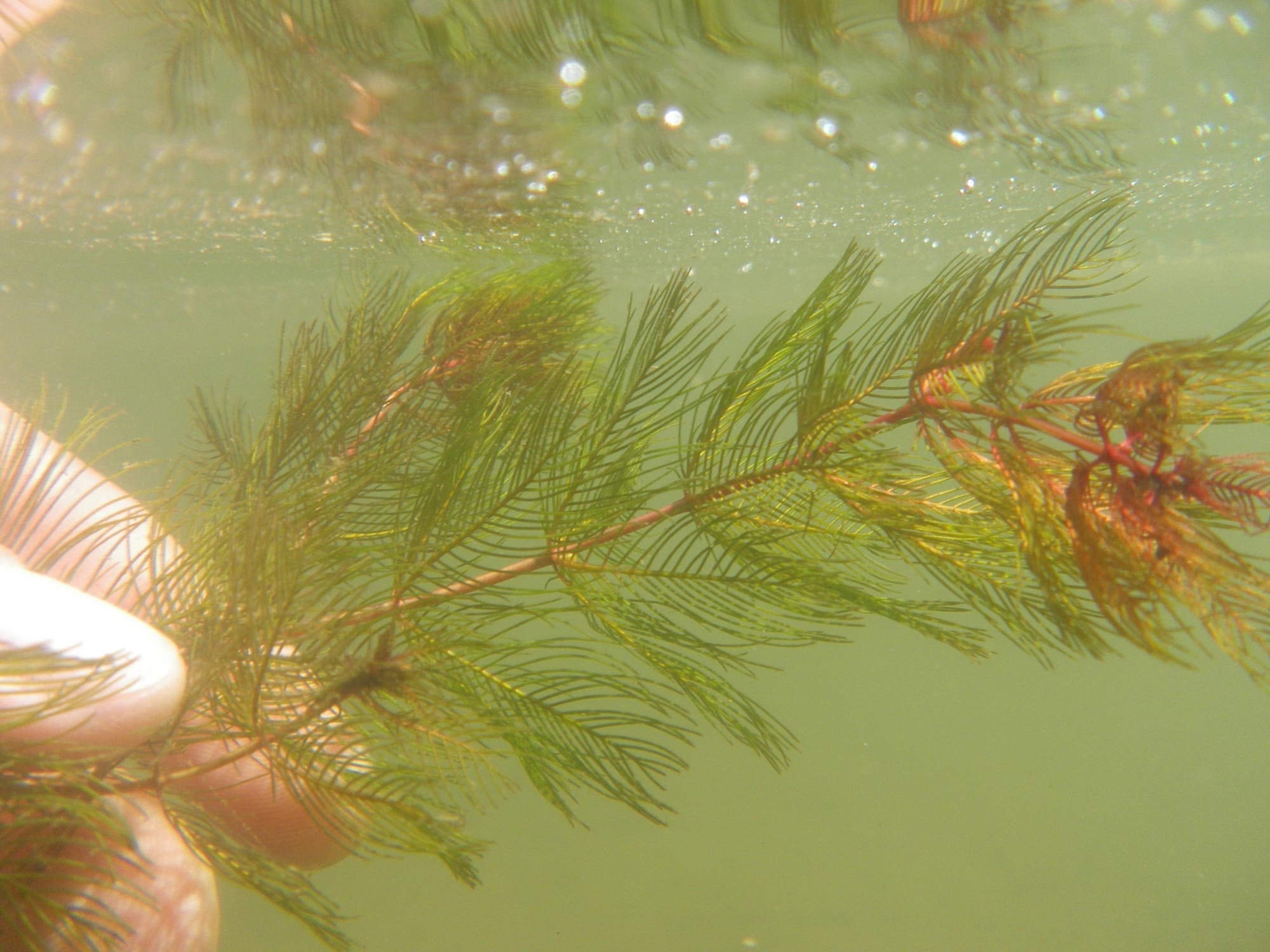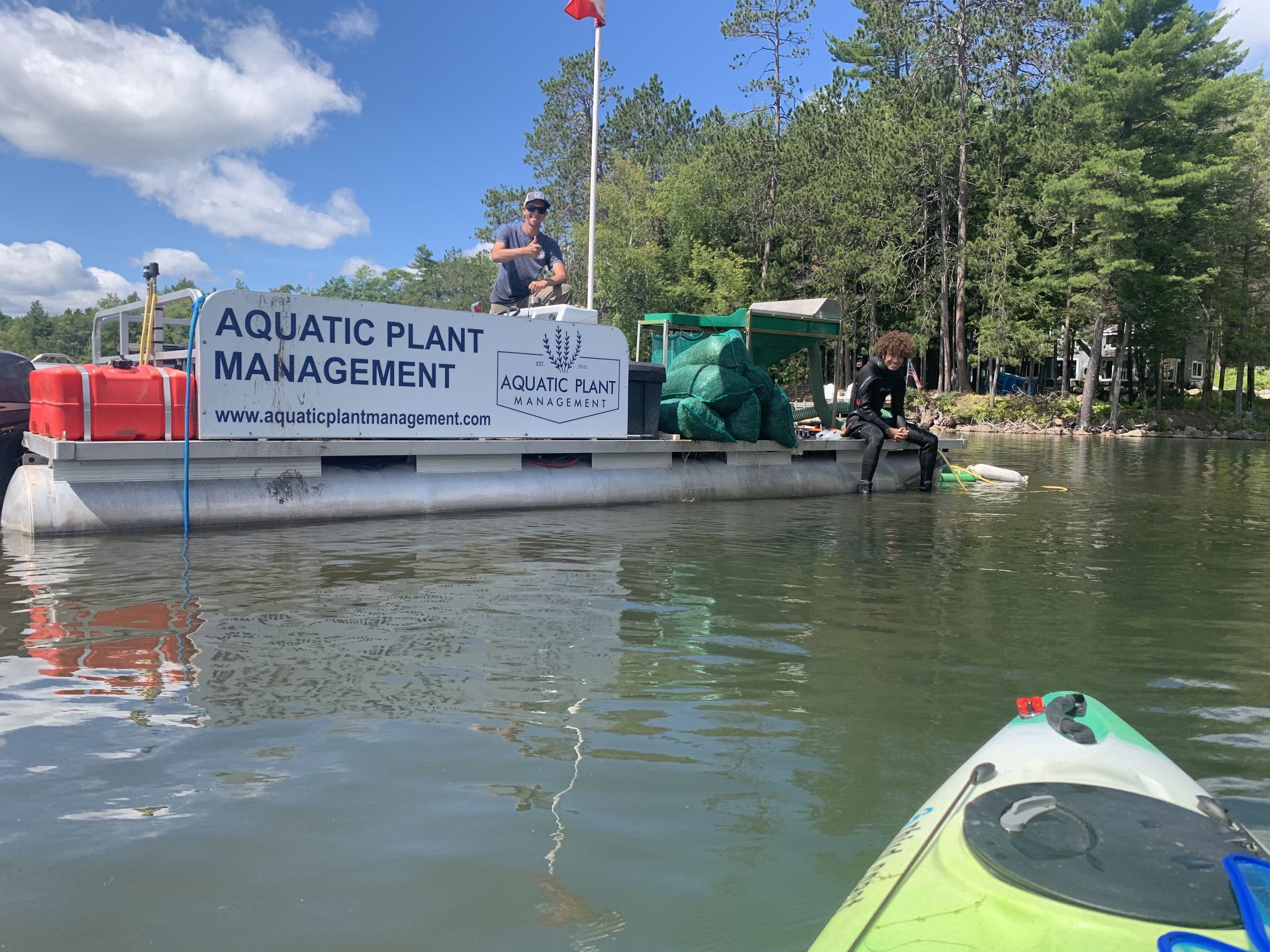
Eurasian Watermilfoil
Since 2006, WLA has been managing the spread of the aquatic invasive Eurasian watermilfoil (Myriophyllum spicatum) with herbicide treatments and contracted Diver-Assisted Suction Harvests (DASH). Continued monitoring and treatment of Eurasian watermilfoil is required to successfully manage the invasive plant, which crowds out native plants, affects water chemistry, and impacts swimming and boating.
Quick Facts:
Eurasian Watermilfoil (EWM) is a submersed, rooted, aquatic invasive species originally from Europe, Asia, and northern Africa that was first reported in Wisconsin in the 1960s.
What is Eurasian Watermilfoil
EWM has a reddish stem whorled with feathery leaves. Each leaf containing 12 or more leaflet pairs. When removed from the water, EWM loses its structure and goes limp. When it reaches the surface of the water, EWM grows a pink flower.
What it looks like:
Identification Tips:
As Eurasian Watermilfoil can easily be confused with its native counterpart, Northern Watermilfoil (Myriophyllum sibiricum), here are some identification tips:
Eurasian Watermilfoil:
Leaves: Feather-like and divided into 12 or more pairs of thin leaflets. Which are arranged around the stem in whorls (groups) of 4. Limp when removed from water.
Stem: Typically 3 to 10 feet long, although it may grow longer in clear water conditions. It ranges in color from green to red.
Flowers: A small, pink stem emerges from the surface to produce red/pinkish flowers
Northern Watermilfoil
Leaves: Dark green and feather-like. Divided into 12 or less pairs of thin leaflets. Which are arranged around the stem in whorls (groups) of 4. Rigid when removed from water.
Stem: Stem is usually green in color.
Flowers: One thing to note is that Northern Watermilfoil also develops turions in the fall, whereas Eurasian Watermilfoil does not.
**There is a Eurasian and Northern hybrid milfoil species. The only way to identify it is a genetic test.**
Control Methods for EWM:
Prevention:
The best way to control EWM is to prevent more from entering our lake. Take action and join us at the boat landing doing CBCW and by reducing nutrient run-off into the lake.
Here’s a refresher on the CBCW protocol:
Inspect and remove all aquatic plants and animals from boats and equipment.
(Before recreating on Wisconsin waters, please review the bait and fishing regulations as well as the list of Aquatic Invasive Species for each body of water)
Drain all water from the boat and equipment
Allow the boat and equipment to dry out of water for at least five days.
Another preventative step is to reduce the amount of nutrient run-off into our lake.
When excess nutrients enter our lake, it provides ample conditions for plants, like EWM, and algae to grow faster and more abundantly. Here is how to reduce that:
Plant native shoreline vegetation
Participating in restorative shoreline efforts can also greatly decrease the amount of unnecessary nutrients feeding into our lake. These plants trap and use the extra nutrients, while also reducing erosion and fostering habitat for butterflies, bees, and birds (Extra amazing fact is that natural shorelines help to deter unwanted guests like geese).
Reduce excess fertilizer usage
If too much fertilizer is placed on lawns or plants, it won’t get absorbed by plants or soil causing it to run-off into the nearest waterbody after a rain event. This enables unwanted plant and algae growth. In compliance with Wisconsin's Phosphorus Rule, be sure to purchase fertilizer that does not contain phosphorus as that is the leading and limiting nutrient that causes algal blooms and undesirable plant growth.
To limit this unnecessary aquatic or weedy plant growth, only fertilize when the soil is actually depleted of nutrients. To determine the nutrient contents of your soil, have it tested by these locally based companies.
For questions about natural shorelines and restorative efforts, check out these resources and contacts:
Some examples of natural shorelines:
2. Manual:
Some examples of manual control are:
Hand harvesting / Raking which can be achieved in wadable depths through snorkeling or using a rake and boat. To do this efficiently, it is important to pull the entire plant (root ball and everything). It is also crucial to follow-up with a net to ensure there are no loose fragments. Before you begin the removal process, please contact us or attend one of the trainings that are being promptly set up. This type of control will only manage the EWM colonies, when you remove the EWM make sure to keep an eye out for any future growth and remove them as soon as possible.
Diver Assisted Suction Harvest (DASH) is another option for removing EWM and AIS in general. Divers are able to reach deeper depths than hand-harvesting/raking. The plants are removed via suction hoses at half the time it would take to hand-harvest. WLA has employed DASH for multiple summers, click here for more information on our efforts to remove Eurasian Watermilfoil.
Benthic Barriers (weed mats) block sunlight from penetrating plants which inhibits growth. There are many options for barriers/mats such as ones that are biodegradable (e.g. burlap) or those that have to be removed after each season (e.g. fiberglass). Research show decreases in both fish and macroinvertebrate habitat and populations when benthic barriers are used. Here is some more info on benthic barriers:
EDIT: If you have any questions or concerns, here are some people to contact:
Brenda Nordin
smaller areas are better managed with these types of techniques. Also, repeated treatments may be necessary to significantly reduce the population.
3. Chemical:
Chemical control involves the use of herbicides, pesticides, etc., to inhibit the growth and spread of unwanted plants and/or organisms.
WLA has employed multiple herbicide treatments, 2,4-D and florpyrauxifen-benzyl (ProcellaCOR), since the discovery of EWM in 2006. There was a recent ProcellaCOR treatment in summer 2024. To prevent diffusion to non-infested areas, barriers are often used to contain the herbicide to the designated area(s).
Chemical treatments are most effective when preformed in early stages of growth (e.g. spring) since EWM is usually the first plant to grow after ice-out. If done early enough, native plant communities are still dormant and will be affected less, which means decomposition rates will be lower and dissolved oxygen (DO) levels stable. The permitting process for aquatic plant management is regulated by the DNR under Chapter NR 107.
Information on the herbicides we have used:
Florpyrauxifen-benzyl Fact Sheet
There is debate about the effectiveness of chemical treatments as well as potential adverse effects on lake biodiversity and chemistry. Here is some more information:
Biological:
Photo Credit: Robert L. Johnson, Cornell University
Through the introduction of a natural predator, biological controls prevent the spread and growth of invasives.
There is limited research on biocontrol’s for EWM, however, researchers are currently looking into milfoil weevils as a way to reduce EWM populations. Milfoil weevils are native to Wisconsin lakes and feed on native milfoil species as well as EWM. When hatched, the larvae travel to the stem and consume the inner tissue, interrupting the transportation of nutrients (Alwin and Cheruvelil). The adult weevils colonize and restrict photosynthesis by feeding on the leaves and stems of the milfoil plant (Alwin and Cheruvelil).
However, for these weevils to do significant damage to EWM beds, they need to have a high density per plant, which is not usually naturally found. Also, over-developed shorelines pose an issue for these weevils because they overwinter in shoreline vegetation. These limiting factors impact the effectiveness of this biocontrol.
Here is more information:
Photo Credit: Havel, Knight, and Miazga
What can you do?
Contact the WLA if you find EWM in the lake. We will demonstrate how to remove it properly. It is important to remove EWM properly as it reproduces through vegetative propagation, so each tiny bit that floats off can form a new plant. Once removed, survey your property regularly and if you notice a new plant, pull it right away.
Check the DNR website to see if the lake you are visiting has any AIS.
Please wait at least 5 days before using your boat on a new lake. This ensures that aquatic invasives are dead and cannot be reestablished.
Participate in the CBCW inspection program. Check out our calendar at the bottom of the Home Page to sign up for training.
Participate in our AIS monitoring program
Participate in the Wisconsin Extension Snapshot Day
WLA budgets about $30,000 per year for this activity, the largest portion of our budget and our primary fundraising objective.
Annually from 2006 to present, WLA has funded a spring survey to document the location of EWM followed by treatments with herbicide or hand pulling as needed. While these methods have proven to be successful at managing the EWM, treated beds can rebound and new beds have emerged that have required repeated treatments at several locations on the lake. One area in particular that has required repeated treatments is the beds near the boat landing; these beds were the first to be discovered and have required several annual treatments. For this reason, we started a Clean Boats Clean Waters program to educate boaters about invasive species.
In 2019, EWM had spread to cover more than 22 acres of Wheeler Lake, an all time high. We implemented an aggressive approach to help manage EWM, treating the area with herbicide. EWM was substantially reduced to 2.2 acres in 2020. A small area (1.5 ac) of persistent EWM was again treated in 2020.




















